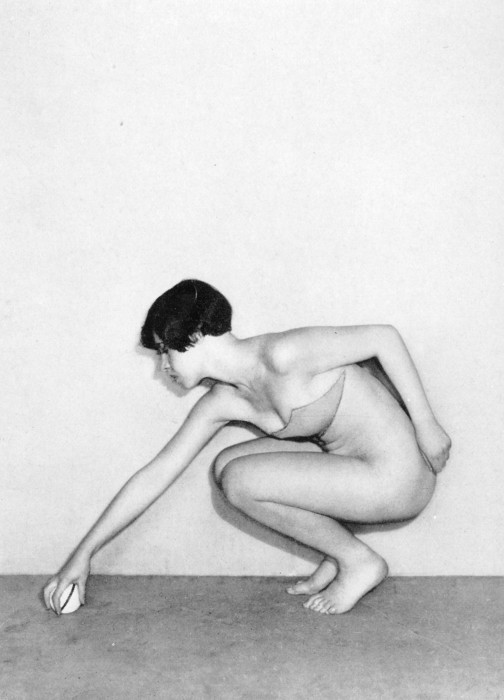The Armory Show
The “International Exhibition of Modern Art” opened in New York City in February 1913. This was the first extensive exhibition of European and American modernist art to be held in the United States. As such, the Armory Show (as it is now known) is considered a major turning point in the history of aesthetic modernism in the United States. The American Posture League, founded in New Jersey in March 1913, does not share in the Armory Show’s fame. In this essay, I argue that it should, because the contemporaneous posture-reform movement illuminates practices of looking that informed the exhibition’s reception.
Former U.S. President Theodore Roosevelt toured the Armory Show with Arthur B. Davies, who, as president of the Association of American Painters and Sculptors, was the exhibition’s lead organizer. When Roosevelt complimented Davies’s art, the latter relished the opportunity to explain abstraction. He tried to illuminate the formal principles in Marcel Duchamp’s futurist-cubist masterpiece Nude Descending a Staircase (No. 2) (fig. 1) by comparing it to his own more conservative work, perhaps the drawing Reclining Woman (fig. 2), also on display. Davies explained the similarities: although his figures were more representational, they were, like Duchamp’s Nude, “all built up geometrically, Mr. President, just full of pentagons and triangles on the inside.” Davies was paraphrasing Paul Cézanne’s order to “classif[y] all the aspects of nature according to the cylinder, the sphere, and the cone,” as translated and quoted in the Armory Show exhibition brochure. In response to Davies’s invitation to see the abstracted figure in geometric terms, Roosevelt made a remark that seems like a non sequitur. He said, “I dare say the Venus of Milo has a skeleton on the inside, and that’s the right place to keep it.”1 Why did Roosevelt comment on the nude’s exposed “skeleton”?
[Figure 1. Marcel Duchamp, Nude Descending a Staircase, (No. 2), 1912. Oil on canvas. The Louise and Walter Arensberg Collection, Philadelphia Museum of Art.]
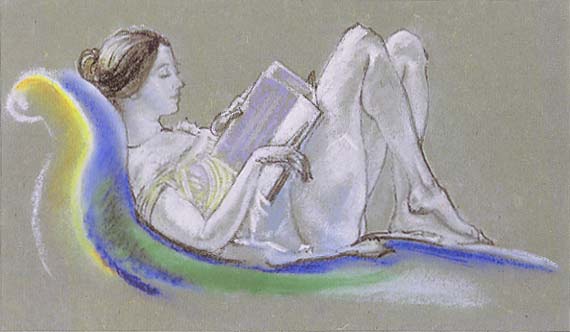
Figure 2. Arthur B. Davies, Reclining Woman, 1913. Pastel on gray Japanese paper. Alfred Stieglitz Collection, The Metropolitan Museum of Art.
Spanning the conversational gap between Davies’s triangles and Roosevelt’s skeletons is a bridge connecting the worlds of avant-garde art and public school physical education. In the early twentieth-century United States, there were multiple visual languages, as there are today, but the Davies-Roosevelt conversation hinged on a shared term—skeleton—and intersecting methods of looking for hidden structures within form. When creators, critics, and collectors of modern art took up the formalist approach, they insisted on the importance of seeing, as if with “X-ray” vision, the compositional structure and underlying shapes (along with line, color, and light). These elements transcended representational and narrative goals for art. At the same time, the physical education and health-reform communities demonstrated healthy and unhealthy posture with visual aids showing skeletal structure (fig. 3 and fig. 4). The Davies-Roosevelt exchange was a moment of translation, of mediation. Be it a painting or a body, abstract aesthetics and contemporary posture reform had visual techniques for attending to internal structure: the “skeleton of form.”
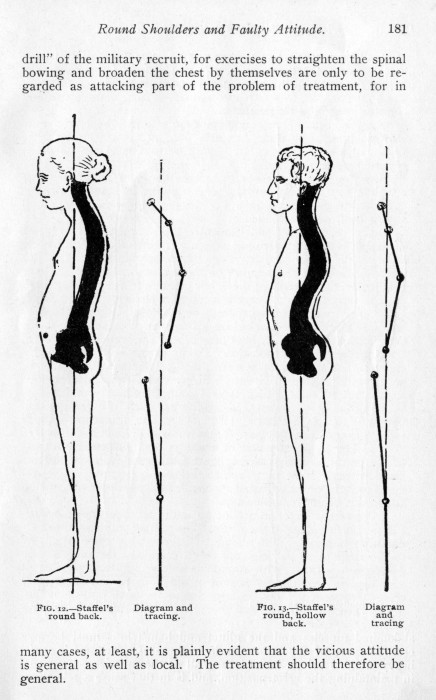
Figure 3. Robert W. Lovett, MD, “Round Shoulders and Faulty Attitude: A Method of Observation and Record, with Conclusions as to Treatment,” American Physical Education Review 7, no. 4 (December 1902): 181.

Helen Mulheron, “Differences in the position of the skeleton in the normal attitude and in lateral curvature of the spine,” in Jessie Bancroft, The Posture of School Children (New York: The Macmillan Company, 1913), 48, originally published in Eliza Maria Mosher, Health and Happiness: A Message to Girls (New York: Funk & Wagnalls Company, 1912), figures 6 and 11.
For readers familiar with this radical exhibition, it may seem perverse to couple it with instrumentalizing posture reforms. Doing so contradicts familiar models in which an intellectual aesthetic modernism defines itself against industrial modernity’s insistence on turning people into machines, and its counterpart in an anesthetizing popular culture that proposes we re-animate as humans only when we consume commodities. I propose that this meeting of two visual skeletons is a translation in Latour’s sense. As explained by Hélène Buzelin, for Latour, “translation designates a process of mediation, of the interpretation of objectives expressed in the ‘languages’ of different intermediaries engaged in an innovative project/process – intermediaries whose viewpoint and interests are not, initially, necessarily the same.”2 The skeletons in question here translate bodies into objects and vice versa, crossing cultural and social contexts to reveal visual practices, in which seeing underlying structure was more important than identifying surface features, form more important than representation. “Skeleton” did not function as a precise equivalent, just as cubists and posture reformers had neither the same goals nor outcomes. Rather, “skeleton” was a point of articulation, a joint between the two cultures of physical education and modernist visual aesthetics. It reminds us that visual practices do not stay within disciplinary boundaries. They roam and hybridize. It is my contention that any analysis of bodily response to the visual requires historicizing the viewing body. In brief, my argument here is that the changing function of visual material in physical education was not only simultaneous to the rise of modernism’s formalist aesthetics, but actually worked in an analogous manner, and thus illuminates the co-constitutive making of a period eye and a period body.
Modern Art’s Skeletons
Exhibited at the Armory Show in the same room with Davies’s Reclining Woman were two prints by Ashcan artist John Sloan that parallel Davies’s conversation with Roosevelt. One depicts art appreciation and the other an anatomy lesson. Both are concerned with visual literacy. In The Picture Buyer (fig. 5), an older man judiciously evaluates what appears to be an abstracted landscape while art dealer William Macbeth and an assistant await his decision. The other gallery visitors crane their necks, their faces betraying expressions of curiosity, confusion, and distaste. They are excluded from his deliberations, perhaps illiterate in the visual skills of art appreciation that consume the seated gentleman’s attention. Standing over his shoulder and also seen in profile, Macbeth appears to be in communion with the picture buyer. Perhaps he is even tutoring the buyer in connoisseurship, just as Davies tutored Roosevelt and others. Both look intently, and their shared understanding divides them from the other people on the periphery, creating two viewing communities.
[Figure 5. John Sloan, The Picture Buyer, 1911. Etching. Gift of Albert E. Gallatin, Metropolitan Museum of Art.]
Nearby in the same Armory Show gallery, another Sloan print, Anshutz on Anatomy (fig. 6), shows American artist Thomas Anshutz giving an anatomy lesson to members of Robert Henri’s art class at the Art Students League in New York City. Accompanied by an almost nude male model, Anshutz squeezes clay into artificial muscles that he will attach to the demonstration skeleton. Thus artists like Sloan, who includes a self-portrait on the far right, learned to visualize the human skeleton and musculature while looking at the living body in motion, such as that of the model who stands nearby. Looking at art and looking at bodies were both learned critical viewing skills. But the kind of viewing communities that Sloan represents in these two prints were not making or looking at Cubist paintings that might be explained in terms of the skeleton of form. Sloan’s work and that of the community of Ashcan artists to which he belonged was considered modern because of its realist subject matter and expressive technique. Their art looked avant-garde at “The Eight” exhibition in 1908, but in the company of painting by Duchamp, Cézanne, and Matisse at the 1913 Armory Show, it was comparatively conservative.
[Figure 6. John Sloan, Anshutz on Anatomy, 1912. Etching. Gift of Mrs. Harry Payne Whitney, The Metropolitan Museum of Art.]
Duchamp and other members of the European avant-garde would have had an additional meaning in mind when they discussed the skeleton of form in art: the scientific technologies that made visible skeletons in living bodies, or that abstracted the skeleton of human movement. To explain Cubism’s goal of reducing physical objects to their “underlying basic forms,” European Cubist, Futurist, and Vorticist artists described an object’s geometry as its skeleton. In 1920, critic Daniel-Henry Kahnweiler wrote, “Like a skeletal frame these basic forms underlie the impression of the represented object in the final visual result of the painting; they are no longer ‘seen’ but are the basis of the ‘seen’ form.”3 This metaphor appears to have been inspired by Röntgen’s X-ray technology that was introduced in 1895. Duchamp, Kupka, Picabia, and other modernists explicitly referenced the visual simplification and metaphysical symbolism of X-rays in their art and writing. Italian Futurists demanded in 1910, “Who can still believe in the opacity of bodies, since our sharpened and multiplied sensitiveness has already penetrated the obscure manifestations of the medium? Why should we forget in our creations the doubled power of our sight, capable of giving results analogous to those of the X-rays?”4
Additionally, Duchamp had seen the abstracted movement studies by Parisian physiologist Étienne-Jules Marey, and in 1967, he explicitly credited Marey’s “chronophotographs” for inspiring his approach in Nude Descending a Staircase (No. 2). Marey’s technique for photographing movement over time involved dressing assistants in snug black head-to-toe suits fashioned with reflective tape running down the outside of each limb (fig. 7). When the costumed model walked in front of a black screen during a long exposure, the developed film negative captured only a staggered series of lines, pure abstracted movement. Marey’s studies, like the X-ray, demonstrated how machines can capture images of movements the human eye cannot perceive.5
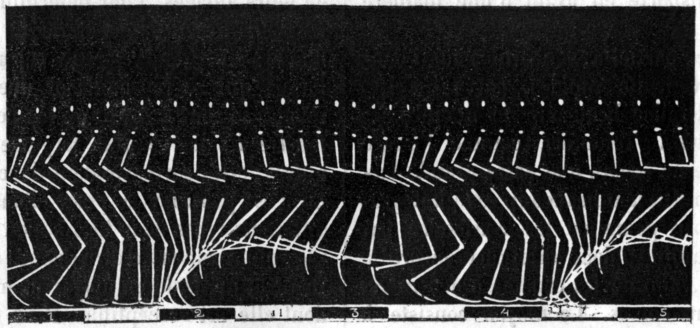
Figure 7. Etienne-Jules Marey, Linear Graph of Running Man in Black with White Stripes, ca. 1882, in “La station physiologique de Paris,” La Nature (1883): 11(2): 277.
If artists described their work in terms of new technologies that powerfully expanded visual experience, how did audiences respond? Some art historians have argued that when medical X-rays revealed to both artists and patients the mysterious and usually invisible inside view of the body, it simultaneously demonstrated the “inadequacy of human sense perception,” and the “limits of surface vision,” destroying the viewer’s trust in the naked eye’s lived experience.6 Similarly, seeing the basic form of objects in the way Cubists saw them could be uncomfortable, especially for viewers who were usually confident when evaluating representational art. Facing modern abstraction, resistant viewers might feel as befuddled as a patient who sees her own solid skeleton and transparent flesh on film for the first time.
Abstraction – both the visual objects and the verbal discourse – may have challenged viewers’ confidence in their perceptual skills. A common complaint about the Armory Show was that artists’ and critics’ language seemed unnecessarily obscure.7 Davies’s visual pedagogy, the way he used the skeletal metaphor to render abstract art accessible, opens a new context for this discourse of skeletons of form, one that offers an alternative to modernism’s alienating tendencies. The translation between Cubist forms and human skeletons that occurred in his conversation with President Roosevelt at the Armory Show becomes more concretely part of the aesthetic discourse I’ve traced above when we recognize that Davies used the term “skeleton” to teach other art collectors about Cubism.
Although Duncan Phillips eventually became an ardent collector of European and American modernism, he resisted at first, preferring the old masters and disdaining abstraction. In a 1917 “elementary object lesson,” Davies pointed out to Phillips the geometric forms in a “picture of a young girl playing a violin.” Phillips recalled, “On the glass [of the framed picture, Davies] marked in chalk the contour of the masses and then removed the glass. The diagram was not unlike a Cubist masterpiece. And Mr. Davies said in all seriousness that this skeleton of form contained all the aesthetic emotion suggested by the subject, but now the rhythm was released from all extraneous interest, from all sentimental irrelevance.”8 Davies gently guided Phillips’s collecting tastes toward modern abstraction by teaching him to see geometric shapes and compositional structure as the “skeleton of form.” The artist convinced Phillips to buy his first Cézanne in 1925, and in 1929 the collector bought the post-Cubist Picasso painting Abstraction, Biarritz (1918) from Davies’s estate. According to the comprehensive institutional history of the museum he founded in Washington, D.C. (known today as the Phillips Collection), it is this specific purchase that proves Phillips’s full “conversion” to avant-garde aesthetics.9
Two weeks after his visit, Roosevelt wrote a scathing review of the Armory Show. He was particularly critical of the abstract imagery, non-referential titles, and “conventional jargon,” but he did not complain about Davies or lump him in with the “lunatic fringe.” Instead, Roosevelt ended by sweetly thanking him for organizing the exhibition.10 Even though Roosevelt never did come around to liking Duchamp’s work, Davies must have spoken to Roosevelt in accessible language. In September 1913, still burdened with post-Armory Show administrative work, Davies commented to AAPS executive secretary Elmer MacRae: “I have been working steadily in town, except for an occasional ball-game to study curves & diamonds, and strenuous shoots across, properly augmented by brains or stopped by bone-heads.” With this little pun, Davies married his visual “study” of simplified form to baseball fanaticism. Curve balls, diamond fields, shoots, brains, and boneheads were common baseball lingo. When the term “bone-head” (or bonehead) entered general usage in early twentieth-century New York, it was baseball-specific. It was associated first and most prominently with a foolish and significant error by batter Frederick Charles Merkle – he prematurely left the field during a game and cost the New York Giants the 1908 pennant – but soon it stuck, such that sportswriters and sports fans alike accused ballplayers of bonehead moves.11 Surely such cross-cultural translations contributed to Davies’s facility in coaxing funds, object loans, purchases, and comprehension from reluctant donors, collectors, institutions, artists, buyers, critics, and audiences in general.
With Sloan, Marey, Duchamp, Roosevelt, and Davies, we have several different perspectives on the artistic skeleton. Sloan’s skeleton was associated with the renewed academic interest in anatomy studies at the end of the nineteenth century, whereas for Duchamp, that term in reference to imagery would have brought to mind the European Cubists’ and Futurists’ appropriation of medical terminology and time-motion study graphics. Marey’s work served industrial capitalism. Davies took his language of form directly from Cézanne, but he moved easily between the other three spheres of reference: American modernists, the European avant-garde, and the agog public who might be convinced to look at abstraction if it could be explained to them in a non-alienating manner, such as by reference to contemporary health campaigns.
Art History in Physical Education
Roosevelt’s idea of the skeleton within form would have been aligned with progressive and populist athleticism. Beginning in the 1880s, he transformed himself from a sickly and “effeminate” young man into a robust adult by participating in physical culture. During his presidency (1901-1909) and in his ongoing campaign for “muscular Christianity,” he advocated vigorous physical education for men.12 In response to the ongoing tuberculosis epidemic, early twentieth-century health reformers investigated ways to improve pulmonary health; freedom from restrictive clothing and cramped postures was an obvious answer. From this context, Roosevelt would have been familiar with the Venus de Milo’s skeleton, well-aware of this visual culture of philhellenic health reform, and of the underlying racial discourse.
At the same time that modernist artists were making art in a visual language that stressed the basic structure within familiar objects, contemporary movement and health experts were training the public in a visual language that emphasized the basic structure of the body. Perceiving the skeleton within animate human form had a long history in medical and comparative anatomy studies, predating X-ray technology in Western culture by at least 350 years. Nineteenth-century anti-corset health reformers regularly contrasted the perfect contours and imagined internal structure of ancient Greek sculptures of the goddess Venus to the modern female torso “compressed and deformed” by tight-laced corsets (fig. 8 and fig. 10). Not only did such images actually visualize bone inside marble, they suggested that female viewers could learn to look in the mirror and imagine their own rib cages, recognizing themselves as willing victims of Fashion in Deformity.13 As this article’s illustrations show, in American physical-education publications from the turn of the century through the time of the Armory Show (and beyond), the visual culture of health reform depicted the skeletons of children and adults, men and women.
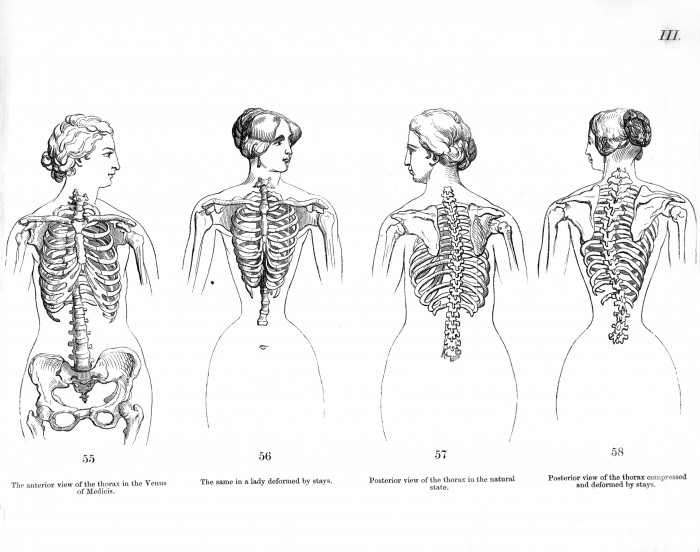
Figure 8. Anterior and Posterior views of the Thorax, from The Gymnastic Free Exercises of P.H. Ling, trans. M. Roth (Boston: Ticknor, Reed and Fields, 1853), Appendix III.
In the late nineteenth and early twentieth centuries, an extended community of American and European dancers and physical culture teachers looked to canonized, and contemporary academic art for models of the body beautiful. Anti-corset health reformers, elite and burlesque performers of tableaux vivants (“living pictures”), American Delsartists, posture and body mechanics educators, and modern dance choreographers all explicitly drew on art historical sources. Each trained viewers to evaluate human physicality represented in two- and three-dimensional art and to respond by imitating or avoiding the depicted postures and gestures. Together they cultivated modes of viewing that would have pre-conditioned Armory Show attendees and critics to think of their own bodies when they looked at art.
Early twentieth-century methods for art-historical physical education were rooted in nineteenth-century physiognomy, racial taxonomies, and other visual inspection practices and were facilitated by mass reproduction and distribution of carte de visite photographs, prints, and plaster-cast art reproductions of classical art imagery. At midcentury, Josiah Nott and George Gliddon visually articulated racial hierarchy with a grid in which the sculpture Apollo Belvedere is the apotheosis of white manhood, and an African is the midpoint between Apollo and a chimpanzee (fig. 9). The counterpart was the Venus de’ Medici or Venus de Milo, who stands for the uncorseted and thus healthy, able-bodied, active and fertile woman. The visual depiction of Venus appeared in health reform tracts, such as when Genevieve Stebbins reprinted William Henry Flower’s graphic in the 1893 edition of Dynamic Breathing and Harmonic Gymnastics. Flower, a comparative anatomist, paired Venus with a corseted women to give an example of “deformity” in his anthropological study of body modifications (fig. 10).14 In these sources, marble sculpture and living bodies are paired with their implied skeletons: male skulls and female rib cages.
The implied comparison of the corset-deformed and headless female torso and the portrait of the male ape is provocative. One might see them as equally abject—the primitive animal and the over-civilized fashion victim. Both sets of neoclassical imagery encouraged adoration and emulation of the “white” classical body and simultaneously criticized deviation from this ideal. Whereas Nott and Gliddon’s image trades in the twisted logic of polygenesis, the distorted Venus offers a neo-Lamarckian critique that encouraged viewers to look at the body for acquired and degenerative characteristics that might inhibit reproduction or mar offspring. These uses of classical imagery for eugenic arguments persisted into the early twentieth century, shared in European and American contexts. When bodybuilders like Eugen Sandow and Bernarr Macfadden were photographed as the Apollo Belvedere or Borghese Gladiator, or French bodybuilder Adrien Deriaz posed as Canova’s Perseus with the Head of Medusa, they appropriated the aesthetics of classical beauty for the politics of race, gender, and imperialism. Prints and photographs exponentially widened public access to such images, and these in turn were essential visual resources and staging opportunities for the period’s burgeoning physical culture movement.15
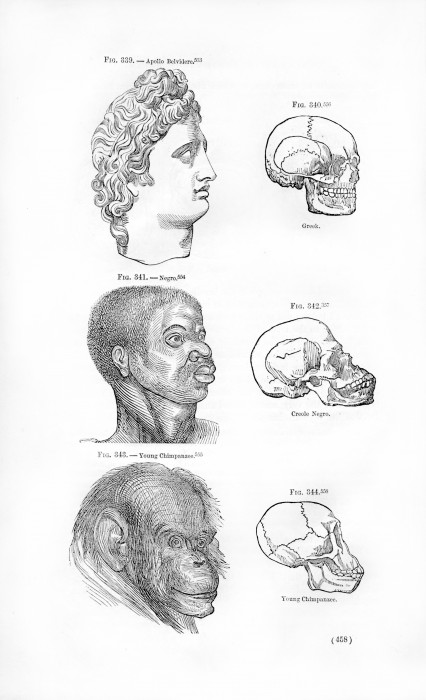
Figure 9. Josiah Clark Nott and George Robins Gliddon, Types of Mankind, 6th ed. (Philadelphia: Lippincott, Grambo & Co., 1854), 458.

Figure 10. William Henry Flower, Fashion in Deformity: As Illustrated in the Customs of Barbarous and Civilized Races (New York: The Humboldt Publishing Company, 1882), re-printed in appendix to Genevieve Stebbins, Dynamic Breathing and Harmonic Gymnastics (New York: Edgar S. Werner, 1893), 146.
Performing Art
While the dress reform context for the Venus image makes it clear that the critical gaze was turned on the self as well as on others, there is another genealogy behind art-historical sources in physical education that deserves attention as well. The trajectory I trace here concerns not only looking at art and thinking of bodies, but the opposite as well—how did looking at bodies and thinking of art consequently alter modes of art consumption? In the nineteenth century, tableaux vivants provided, simultaneous to the visual culture of racializing science and anti-corset health reform, another translation between static art and modern performance, the ancient and the contemporary body. This was an alternate practice that primed viewers to think about their own bodies when they looked at art. These episodes multiplied in the late-nineteenth and early-twentieth century body cultures of the United States, first in Delsartism, then in modern dance and the posture reform branch of physical education.
American Delsartism united physical conditioning with mental appreciation of artistic forms; participants recreated classical, Renaissance, and Asian sculpture and paintings in tableaux vivants. In 1902, Genevieve Stebbins encouraged followers to embody art by studying the “poise and attitude” of original marbles in Europe or, failing that, plaster casts or photographs. Then “stand in front of a large mirror and attempt to make yourself a living duplicate of the picture.”16 Isadora Duncan, Ruth St. Denis, and Ted Shawn—all students of American Delsartism—borrowed extensively from art-historical sources. Duncan’s early exposure to the Elgin marbles, Tanagra figurines, and Hellenic vase paintings at the British Museum provided her with a distinctive movement vocabulary. St. Denis and Shawn drew upon a wider range of sources, expanding to appropriate non-Western and pre-Hellenic visual sources for their choreography, including Aztec and Egyptian, Minoan, and Hindu art, as well as the Greek.17 These performances were recreated in schools and on theatrical tours. The Duncan and Denishawn companies formulated new standards of dance education that contributed to the integration of Delsartist movement fundamentals in university degrees for dance and physical education teachers, male and female.18
In the area of posture reform, art history and physical education merged in ways that show the transition from the mere identification and imitation of the important figures depicted in paintings and sculpture to more formal and physiological modes of viewing art. In the 1890s through 1920s, several educators recommended art historical sources for learning good posture. In addition to the Delsarte and dance instructors named above, others who used this approach include Robert Tait McKenzie, Jessie Bancroft, Leah Thomas, Ivalclare Sprow Howland, Mary S. Haviland, and Bess Mensendieck.19 McKenzie was a professor of anatomy and physical education (at McGill University and then the University of Pennsylvania) who became increasingly interested in the pedagogical potential of the arts in physical education. In his simultaneous and related career as a sculptor, McKenzie specialized in cast bronze figurines of athletes whose physiques were based on classical models combined with anthropometric measurements collected from college students. McKenzie was the president of the American Physical Education Association (APEA) when the society held its annual meeting in Newark, New Jersey less than two weeks after the 1913 Armory Show closed. The APEA event featured several talks on posture reform, and the American Posture League was also established in that year, with McKenzie on the first board of directors. Jessie Bancroft was the first president of the American Posture League. Her 1913 teacher’s guide, The Posture of School Children, documents “efficiency methods” for posture detection and correction, and offers a similar combination of philhellenic eugenics. 1913 was a big year for posture reform, and it was a long time coming.
Mathematically speaking, by 1913, there were hundreds of thousands of people in New York City who had undergone these posture lessons and would have seen its visual culture. Most likely, they would be 25 years old or younger, or have children in that age range, or be a teacher of those children. By 1894, Bancroft had introduced techniques from the “German, Swedish, military and Delsarte systems” to children in the New York public schools. After conducting scientific tests of her method for two years, she estimated she had reached at least 200,000 school children per year. That does not begin to account for all the children who entered public schools where her posture lessons may have been taught in the two decades since Bancroft’s trials. Her educational community extended after she began regularly giving presentations on posture reform to the Columbia Teachers College in 1901 and she further expanded her audience in “many lectures during 1911 – 1912 to the public school force of New York City,” finally publishing the work in 1913.20
Some of Bancroft’s visual aids looked back to older tableaux-style physical education uses of art history, and others reflected current physiological studies. As part of a distinctly eugenicist chapter on “erect carriage as an expression of intelligence and character,” “energy,” and “physical vigor,” Bancroft recommended that teachers show children photographs of ancient and contemporary art, including the Parthenon friezes, neoclassical sculpture by American sculptors Augustus Saint-Gaudens and Frederick MacMonnies, and portraits by Thomas Gainsborough, such as The Baillie Family (ca. 1784), the frontispiece of her 1913 text. Portraiture was generally useful because “artists usually understand the full value of the erect position,” and the eighteenth-century British portraitists were especially sensitive to the distinction that “stately carriage” gives to their subjects. Furthermore, “with pictures of Washington and Lincoln before them, of kings and queens, of heroes and pioneers, who figure in history and literature, it should not be hard to inspire any child with a desire for the best carriage he can cultivate.”21 This lineage of philhellenic art appreciation extends early nineteenth-century racist theories of beauty and late nineteenth-century efforts to remake oneself into an objet d’art in tableaux vivants, and it frequently served a eugenicist agenda. The comportment lessons one might take from art-historical sources contributed to the making of an embodied self and to the kinesthetic communication of “refinement.”
Progressive-era posture-reform language, imagery, and practices taught a self-reinforcing perceptual loop of visually observing one’s body contours, extrapolating structure, and kinesthetically adjusting skeletal and muscular alignment. Schoolteachers taught their young students to become aware of and alter their fundamental habits of alignment and movement by using a variety of games and drills. Bancroft recommended that the teachers themselves develop a special visual acuity in order to recognize postural deviation and then teach this viewing skill.22 Visual aids published in physical education journals and textbooks and distributed for classroom and private use often featured section views of a child’s body to show the skeleton’s position during good and bad posture. Some were quite detailed and others were abstracted, not unlike Marey’s chronophotographs that reduced the moving human figure into a series of lines (fig. 7). For example, a 1902 illustration provides both a section view with emphasized spinal column and an abstracted postural schema adjacent to each figure (fig. 3), a technique that was repeated in wall charts distributed by the American Posture League, circa 1914, and then reproduced in teachers’ handbooks (fig. 11). This technique was part of their visual pedagogy, coaching viewers to see the skeleton in the slouch and then to simplify it into a geometric form that would accentuate deviations from a straight line (see the abstracted spine directly beneath each of the three figures).23 Streamlined skeletal imagery was familiar to the general public. For those directly involved in body cultures, images that abstracted the body’s shape into spare structural lines were commonplace.
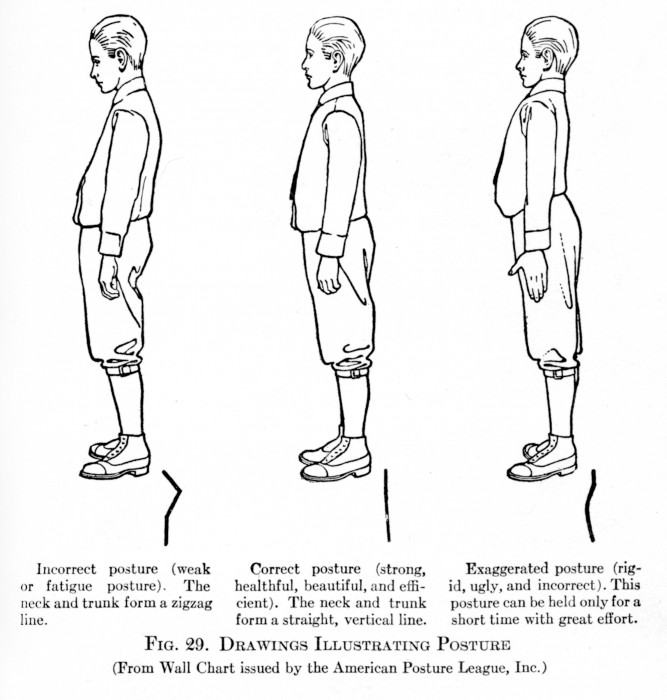
Figure 11. American Posture League classroom visual aid, c. 1914, published in J. Mace Andress, Health Education in Rural Schools (Boston: Houghton Mifflin Company with the Riverside Press, 1919), 231.
It is hard to know how much of this physical education context was familiar to Arthur B. Davies when he walked Theodore Roosevelt through the Armory Show.24 It is more evident that by the early 1920s such somatic-artistic visual translations had become central to the ways he theorized both making and viewing art. At some point in the late 1910s, Davies began practicing Bess Mensendieck’s posture techniques as a treatment for his angina. According to the painter’s model, Davies performed the Mensendieck exercises with deliberation and dedication, swearing to their health benefits and vainly priding himself on the youthful, erect posture that he maintained into his fifties.25 The Dutch American started her exercise system with a goal shared by other Delsartists: she wanted to make the human body into an art form. In the 1890s, she moved to Paris and took studio courses in sculpting clay from life. “If some models could have the beautiful lines of masterful Greek statues why couldn’t others?” she wondered. “To be sure, not everyone could be a Venus or an Adonis, but it seemed that many did not develop the full potentialities of their bodies.” In comparison to the perfected bodies in Hellenic art, the contemporary models had heavy thighs, puffy arms, narrow chest carriage, and jerking movements. Mensendieck decided to become—in her own words–a “sculptor in flesh.”26
Mensendieck’s publications, both the early work in German and later versions in English, featured the same illustrations that her former Delsarte teacher Genevieve Stebbins had published to suggest bodies worthy of imitation.27 In Mensendieck’s approach, we see a significant change from earlier perspectives in art-historical physical education, showing that a keen eye might diagnose negative and positive postures in art rather than simply receiving racist ideology clothed in classicism. Mensendieck praised the Vatican’s Crouching Venus for a bending position that was “a perfect example of the esthetic, as well as the mechanically correct, way to assume a squatting posture.” In contrast, there was the unsightly and unhealthy bend “from the waist ‘à la Millet,’” a reference to François Millet’s Gleaners (fig. 12). This kind of comparison evidently worked, for she repeated it several years later in the American “It’s Up to You!” In it, Mensendieck’s disciple Gerta Ries-Wiener demonstrates a Venus-like position for picking something off the ground. Commenting on Nickolas Muray’s photographs, Mensendieck added that this position was more efficient and attractive and had more “physiological rhythm” than the arm extension she demonstrates as well (fig. 13 and 14).28
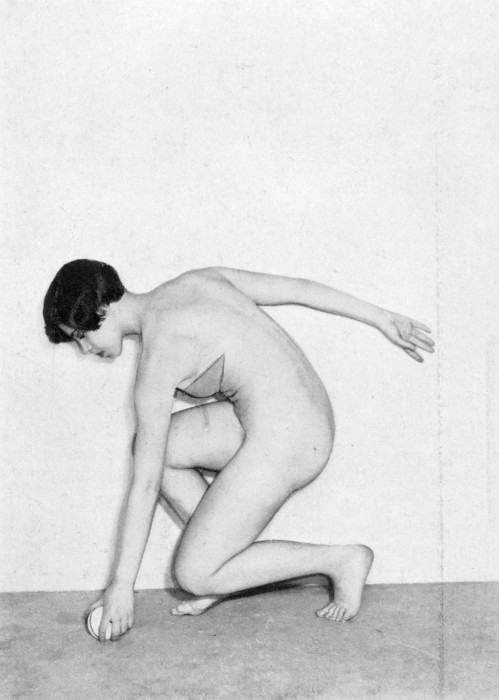
Figures 13 and 14. Mensendieck teacher Gerta Ries-Werner demonstrating bad posture (top) and good posture based on the Crouching Venus (bottom), photographed by Nickolas Muray, published in Bess M. Mensendieck, “It’s Up to You!” (New York: Mensendieck System Main School, 1931), 100, 104. Courtesy Nickolas Muray Photo Archives.
In her 1918–1919 American publications on Standards of Female Beauty, Mensendieck provided an illustration of Canova’s Pauline Borghese and a detail from Bertel Thorvaldsen’s The Dance of the Muses on Helicon, both as examples of good form. Of the five central figures in the Thorvaldsen relief, she wrote, “Perfect Muscle Relief all along the Spine. Perfect middle line. Lateral Pelvis uptilt too extreme. In right hand figure note weight on inner foot margin.”29 At the time she published this, Mensendieck was based in Manhattan and giving lessons in her studio to dancers, models, artists, businessmen, and elite women who wanted to improve their posture. Over time, Mensendieck became increasingly explicit about what and how the viewer could learn from such images. What they could learn was efficient muscle use for energy conservation, which in turn would provide the impression of grace.
Mensendieck’s method of instruction combined verbal descriptions with an assumption that the viewer’s body imitates visual information either in explicit external movements or in subtle kinesthetic images that combined internal muscle memories with the visual information. The suggestion that works of art provided ideo-motor stimulation, visualizations that lead viewers to re-enact what they see, comes through explicitly and at greater length in Mensendieck’s 1927 German study about graceful and efficient arm movements. Bewegungsprobleme: Die Gestaltung Schöner Arme (Movement Problems: The Arrangement of Beautiful Arms) features forty-seven paintings and sculptures illustrating upper body carriage, among them. Hodler’s Spring, which could not communicate the theme of awakening love because “an artist’s psychic message does not work on the soul of the viewer if this must be occupied at the same time with overcoming the shock of anatomical representation.” In other words, the artist’s representation gave the viewer a beneficial or deleterious “psychic impression” that could change his or her posture. Moreover, these characteristics of form trumped the power of visual narrative.30
When physical educators like Mensendieck, or before her, Bancroft, assumed that images had this power to stimulate kinesthetic empathy, they were building on the literature of experimental physiological psychology. At the turn of the century, these studies occupied the bulk of the meetings and publications of the American Physical Education Association, and in 1903, Bancroft explained that posture adjustment occurred through a kinesthetic re-enactment of visual stimuli: “Imitation is one of the great economic agencies of the mastering of new co-ordinations. The person who sees another perform an exercise has that exercise already partly coordinated in his own nervous system, so closely related are the motor and sensory powers.”31 In the contexts of late nineteenth and early twentieth-century physical education, images interpellated viewers, prompting, demanding even, performative responses.32
Physical education pedagogy simultaneously trained a period eye and a period body, inextricably linked through the perceptual cycle of observation and performance, to both conform to and exceed normative expectations of self-presentation. In the early 1900s, there was a broad public familiar with contemporary self-conscious posture and movement exercises. Many people had seen the visual aids that emphasized the relationship between the body’s internal skeletal structure and its external contours, in a variety of settings. This viewing mode helped to set the stage for artists, art critics, historians, and collectors to perceive interactions between the aesthetic object and the somatic experience of making, viewing, or posing for art. Physical education techniques prompted this mode of seeing and conditioned the public’s reception of modern art.
Feeling Form
It wasn’t only the conservative field of physical education that assumed viewers would identify with images. And, whether in the gym or art gallery, that identification was not limited to surface identifiers of social identity, but to underlying muscle memory related to form and movement. In the art world, those for and against modernism subscribed to physiological aesthetics –aesthetic theories of kinesthetic response, based in experimental physiological psychology.33 Modernist artists anticipated and attempted to provoke specific physiological responses in viewers – based on formal elements, not simply surface subject matter.
The stylistically eclectic Francis Picabia came from France to participate in the Armory Show, hot with a new idea. He wanted to paint pictures that compelled viewers to move or at least feel an incipient/potential movement, an idea he took from the physical culturist Albert Cozanet. Publishing under the name Jean D’Udine, Cozanet asserted that the motor habits of posture and gesture are the source of all aesthetic emotion, because, as summarized by Arnauld Pierre, “All aesthetic emotion is connected to motor force, all art manifests from gesture, incarnates corporeal postures, from motor habits.” Provided with visual stimuli, the viewer experienced an empathetic kinesthetic response. This was the basis for the paintings Picabia made between 1912 and 1914; from this group of paintings, Dances at the Spring (fig. 15) was on display at the Armory Show.34
[Figure 15. Francis Picabia, Dances at the Spring, 1912. Oil on canvas. The Louise and Walter Arensberg Collection, Philadelphia Museum of Art.]
In one of the Armory Show galleries on the walk between Duchamp’s Nude Descending a Staircase (No. 2) (fig. 1) and Davies’s Reclining Woman (fig. 2), Davies and Roosevelt would have passed John Marin’s watercolors of the Woolworth Building, part of a series inspired by Manhattan architecture (fig. 16). Not long before the Armory Show, Marin wrote of his process of empathy and visual animation, “You cannot create a work of art unless the things you behold respond to something within you. Therefore, if these buildings move me they, too, must have life. . . . It is the more they move me the more I feel them to be alive. It is this ‘moving of me’ that I try to express.”35 In the same vein, Davies’s model Edna Potter commented that whereas dancers transmit bodily rhythm directly to audiences (who breathe or hold their breath with the performer), for the visual artist the same act of “transmission” occurred, but it happened “through the use of an intermediary, through color, form, or sound.”36 Based on this idea, some viewers believed they could extrapolate the precise nature of the artist’s physiological condition from the work. Furthermore, because they assumed there was universal and automatic kinesthetic empathy, the next step in this line of thought was that the art object healed or harmed the viewer, by communicating the artist’s personal rhythms through the art.
[Figure 16. John Marin, published by Alfred Stieglitz, Woolworth Building (The Dance), 1913. Etching on ivory laid paper, Alfred Stieglitz Collection, The Art Institute of Chicago.]
Artist/critic Guy Pène du Bois used the same assumptions about physiological communication via art to smear Davies, implying that the body of the artist and that of his figures shared an unhealthy neurasthenic quality. Davies “spends a lot of time avoiding . . . the danger of a shock” because “shocks are devastating to taut nerves,” Pène du Bois wrote, adding that Davies fit with the “tired or frail or too sophisticated bodies” of non-heteronormative proponents of Aestheticism such as “Charles Baudelaire and Oscar Wilde.” Davies’s art attracted the “normal, healthy, disinterested male very rarely.”37 In contrast, Pène du Bois enjoyed being part of Robert Henri and his realist followers’ machismo, in which artists thought of themselves as “strenuous” and “rough-riding,” key terms in President Theodore Roosevelt’s campaign for American masculinity. For Henri’s crowd, “art and manhood was thus compounded into one—an incredibly healthy unity for that time.”38
Pène du Bois’s subtext contrasts a vigorous “healthy” masculinity to a neurasthenic and highly refined effeminacy or even homosexuality, as does a 1918 cartoon of an artist explaining his painting, “Impression of the Soul of a Barefoot Dancer,” to distracted World War I veterans recently returned from the front (fig. 17). Despite injuries—perhaps even because of the injuries, in the post–Civil War iconography of the heroic “empty sleeve”—their masculinity surpasses that of the artist, whose outfit recalls Wilde’s Little Lord Fauntleroy suit. We see here the imaginary association of neurasthenia, effeminacy, homosexuality, and aesthetic sensibility.39
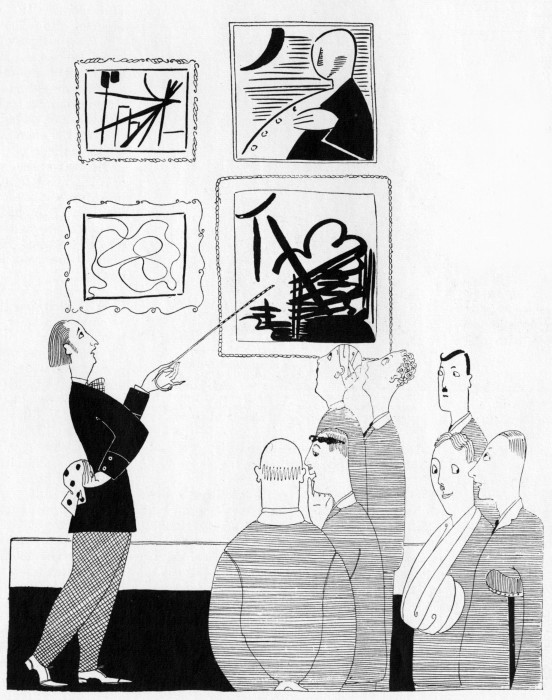
Figure 17. “How to Entertain Wounded Soldiers [Exhibition of Modernist Art],” Vanity Fair, December 1, 1918, 35.
Price’s comparison to the macho Roosevelt is surprising because other contemporaries (aside from the vituperous Pène du Bois) found Davies’s manner as well as his imagery more retiring and ethereal. These characterizations by Pène du Bois and Price play out the drama of neurasthenic discourse’s gendered binaries in the context of modernist aesthetics. Davies is cast as the overly refined feminized artist, who is so nervous that he needs and tries to give his viewers a visual “rest cure.” The alternative was a Rooseveltian masculinity, curing or preventing neurasthenia through “strenuous” activity, not rest. Gail Bederman identifies the “neurasthenic paradox” that underlies this dichotomy. For white American men, the more civilized they became, the more feminized they seemed to be. Applied in the context of American art, neoclassical or realist imagery was safe manly ground, but abstraction made viewers lose their cool and “degenerate” into a perceived nonwhite animalistic primitivism.41 Does this paradox explain Roosevelt’s behaviour – supposedly he “waved his arms and stomped through the Galleries” – at the Armory Show.42 Was Roosevelt erring on the side of primitivism, telegraphing his masculinity with feigned shock rather than kinesthetically empathizing with a distorted and thus potentially distorting form?
Reconstructing the Armory Show’s avant-garde aesthetics within posture-reform practices and popular athleticism revives early twentieth century translations between abstraction and embodiment. Previous historians’ equation between disorienting X-rays and perplexing abstraction is compelling, as long as we believe the X-ray visual technology alienated patients by objectifying their bodies. And yet, posture reformers urged a reflexive loop in which an X-ray self-visualization technique prompted kinesthetic self-awareness and continuous adjustment. Such technologies, Peter-Paul Verbeek reminds us, are contingent, having “different impacts in different contexts.”43 By drawing parallels between cubist structure and the human skeleton, Davies was trying to make abstract art more accessible. Roosevelt took “skeleton” back to physical “fitness,” resituating this viewing technique within a pre-X-ray practice of looking for the hidden skeletons in art, and perhaps refusing to identify with it because the philhellenic body of posture reform was nowhere to be seen.
The uses of art history in physical education offer the possibility that viewers were primed to see the “skeleton of form” in Duchamp’s Marey-inspired Nude Descending a Staircase (No. 2) or to feel the movement of Marin’s Woolworth Building, because they were accustomed to abstract posture images that interpellated an empathetic kinaesthetic response. More importantly, it should also draw our attention to the convergence of formalist and physiological modes of viewing. Beyond the skill of abstracting the internal structure of forms, the visual culture of physical education offers an example of how concepts from physiological science simultaneously entered the realms of avant-garde aesthetics and disciplinary posture reform. These networks of activity formed an interwoven logic. The skeletons in translation are but one point of entry.
Davies-Roosevelt exchange as quoted in Walter Pach, Queer Thing Painting (New York, Harper & Brothers 1938), 200; Cézanne quoted from letter to Emile Bernard, April 15, 1904, as paraphrased by Elie Faure in “Cézanne,” trans. Walter Pach, International Exhibition of Modern Art (New York: American Association of Painters and Sculptors, 1913), 66. Bennard Perlman identified Davies’s paraphrase in The Lives, Loves, and Art of Arthur B. Davies (Albany, NY: State University of New York Press, 1999), 231-32. For a comprehensive catalogue, see Milton W. Brown, The Story of the Armory Show (New York: Abbeville Press, 1999). To see the exhibition floor plan with listings of the works displayed in each gallery, see http://xroads.virginia.edu/~MUSEUM/Armory/galleries.html. For a treasure chest of primary sources, see armoryshow.si.edu. For a recent reappraisal of the Armory Show, including Davies’s role, see Marilyn Kushner and Kimberly Orcutt, eds., The Armory Show at 100: Modernism and Revolution (New York: New York Historical Society, 2013. ↩
Hélène Buzelin, “Translations ‘in the making’,” in Michaela Wolf andAlexandra Fukari, eds., Constructing a Sociology of Translation (Philadelphia: John Benjamins Publishing, 2007), 137; Bruno Latour, We Have Never Been Modern, trans. by Catherine Porter (1991; Cambridge, Mass.: Harvard Univ. Press, 1993). ↩
Daniel-Henry Kahnweiler, excerpt from The Rise of Cubism, 1915, English trans. (1920; 1949), in Chipp, Theories, 258. ↩
Umberto Boccioni, Carlo Carra, Luigi Russo-lo, Giacomo Balla, Gino Severini, Technical Manifesto of Futurist Painting (Milan: 1910), translated by P.T. Marinetti, and here quoted from Linda Dalrymple Henderson, “X-Rays and the Quest for Invisible Reality in the Art of Kupka, Duchamp, and the Cubists,” Special issue: Revising Cubism, Art Journal 47, no. 4, (Winter 1988): 324, 323–40. ↩
Anson Rabinbach, The Human Motor: Energy, Fatigue, and the Origins of Modernity (Berkeley: University of California Press, 1990), 104-115. In “X-Rays,” Henderson argues that a similar image by Paul Richer, this time a drawing based on Albert Londe’s chrono-photograph, may have been a source for Duchamp’s Nude (331-32); it bears a certain resemblance, but Rabinbach cites Duchamp himself crediting Marey (115). ↩
Henderson, “X-Rays,” 325; Michael Leja, Looking Askance: Skepticism and American Art from Eakins to Duchamp (Berkeley: University of California Press, 2004), 5. For other modernists’ conceptions of X-ray vision, see Linda Dalrymple Henderson, “Francis Picabia, Radiometers, and X-Rays in 1913,” The Art Bulletin 71, no. 1 (March 1989): 114–23; Rachael Ziady DeLue, “Diagnosing Pictures: Sadakichi Hartmann and the Science of Seeing, circa 1900,” American Art 21, no. 2 (Summer 2007): 53–64. DeLue argues that when scientific machinery made the invisible visible, artists claimed to have the same perceptual powers as the technology and critics saw themselves as doctors, able to read the results for signs of repressed physical (or psychological) pathologies. ↩
Joanne M. Mancini, Pre-Modernism: Art-World Change and American Culture from the Civil War to the Armory Show (Princeton and Oxford: Princeton University Press, 2005), 155. ↩
Duncan Phillips, “Fallacies of the New Dogmatism in Art [Part 1],” The American Magazine of Art 9, no. 2 (December 1917): 45. ↩
Erika D. Passantino, The Eye of Duncan Phillips: A Collection in the Making (Phillips Collection in association with Yale University Press, 1999), 315. ↩
Theodore Roosevelt, “Roosevelt on Cubism: A Layman’s View of an Art Exhibition,” Outlook 103 (March 29, 1913), 719—20; Brown, Story of the Armory Show, 259. ↩
Arthur B. Davies to Elmer McRae, 10 Sept. 1913, Elmer Livingston MacRae Papers, mf. 4131 or 4132, frame 856, Archives of American Art; Paul Dickson, The New Dickson Baseball Dictionary (New York: Houghton Mifflin Harcourt, 1999), 75-76, 82, 446. ↩
Gail Bederman, Manliness and Civilization: A Cultural History of Gender and Race in the United States, 1880-1917 (Chicago: University of Chicago Press, 2008), 170-71. ↩
M. Roth, trans. ed., The Gymnastic Free Exercises of P[er] H[enrik] Ling (Boston: Ticknor, Reed, and Fields, 1853), fold-out plate III following p. 136; William Henry Flower, Fashion in Deformity: As Illustrated in the Customs of Barbarous and Civilized Races (London: Macmillan, 1881), 80. On dress reform, see Patricia Cunningham, Reforming Women’s Fashion, 1850–1920: Politics, Health, and Art (Kent, Ohio: Kent State University Press, 2003). ↩
J.C. Nott and Geo R. Gliddon, Types of Mankind , 6th ed. (Philadelphia: Lippincott, Grambo & Co.,1854). ↩
I am grateful to Ellery Foutch for sharing with me her unpublished research on Sandow. See Tamar Garb, Bodies of Modernity: Figure and Flesh in Fin-de-Siècle France (London: Thames and Hudson, 1998), 54-79; Fae Brauer, “Eroticizing Lamarckian Eugenics: The Body Stripped Bare during French Sexual Neoregulation,” and Anthea Callen, “Man or Machine,” both in Fae Brauer and Anthea Callen, eds., Art, Sex and Eugenics: Corpus Delecti (Aldershot, England: Ashgate Publishing Limited, 2008), 114–18, 141–52; Christina Cogdell, Eugenic Design: Streamlining America in the 1930s, (Philadelphia: University of Pennsylvania Press, 2004), 200–1. ↩
Genevieve Stebbins, Delsarte System of Expression, 6th ed., rev. and enl. (New York: Edgar S. Werner Publishing & Supply Co., 1902), 458–59. ↩
Isadora Duncan, My Life (1927; New York: Liveright, 1995), 44, 53; Ann Daly, Done into Dance: Isadora Duncan in America (Bloomington: Indiana University Press, 1995), 92–97; Jane Desmond, “Dancing out the Difference: Cultural Imperialism and Ruth St. Denis’s Radha of 1906,” Signs 17 (Autumn 1991): 28 – 49; Jane Sherman, The Drama of Denishawn Dance (Middletown, CT: Wesleyan University Press, 1979). ↩
Jane Sherman, Denishawn: The Enduring Influence (Boston: Twayne Publishers, 1983), 11–22; Ted Shawn, Dance We Must; Lectures Delivered by Mr. Shawn at George Peabody College for Teachers, Nashville, Tennessee, from June 13th to July 2nd, 1938 (Pittsfield, MA: The Eagle Printing and Binding Company, 1940), 47–50, 108–13; Daly, Done into Dance, 116; Patricia Vertinsky, “Transatlantic Traffic in Expressive Movement: From Delsarte and Dalcroze to Margaret H’Doubler and Rudolf Laban,” International Journal of the History of Sport 26, no.13 (October 2009):2034–40. ↩
Carma R. Gorman, “Educating the Eye: Body Mechanics and Streamlining in the United States, 1925 – 1950,” American Quarterly 58, no.3 (September 2006): 839-868, 853–54. ↩
Jessie H. Bancroft, The Posture of School Children: With Its Home Hygiene and New Efficiency Methods for School Training (New York: The Macmillan Company, 1913), viii; “Miss Bancroft’s Rapid Progress,” New York Times (June 10, 1894), 19. ↩
Bancroft, The Posture of School Children, 275–79, 250. ↩
Bancroft, The Posture of School Children, 231–36. ↩
Robert W. Lovett, M.D., “Round Shoulders and Faulty Attitude: A Method of Observation and Record, with Conclusions as to Treatment,” American Physical Education Review 7, no. 4 (December 1902): 171–86; J. Mace Andress, The Modern Health Crusade: A National Program of Health Instruction in Schools, 5th ed. (1917; NY: Published by the National Tuberculosis Association, 1922), 34–35. On Bancroft and the American Posture League, see also Gorman, “Educating the Eye,” 843–53. ↩
In 1913, three of Davies’s children were between the ages of 16 and 20. It’s likely they would have had some of this posture education. Perlman, Lives, 396–97. ↩
Wreath McIntyre Mason to Brooks Wright, October 10, 1967, Brooks Wright Collection, Archives of American Art, Smithsonian Institution; see also Perlman, Lives, 288-89. ↩
Bess M. Mensendieck, Look Better, Feel Better (New York: Harper & Brothers, 1954), 4-5. I have not discovered where Mensendieck attended art school in Paris, but based on the timing and strong correlations between her work and that of anatomist Paul Richer, it may be that she studied with him at the École des Beaux-Arts. For an extended discussion, see Robin Veder, “Seeing Your Way to Health: The Visual Pedagogy of Bess Mensendieck’s Physical Culture System,” The Visual Turn in Sports History, special issue of International Journal of the History of Sport 28: 8 (May 2011): 1336 – 1352. ↩
Nancy Lee Chalfa Ruyter, The Cultivation of Body and Mind in Nineteenth-Century American Delsartism (Westport, CT: Greenwood Press, 1999), 69. ↩
The original artwork appears in Bess M. Mensendieck, Körperkultur der Frau: Praktisch Hygienische und Praktisch Ästhetische Winke, 5th ed. (1906; Munich: F. Bruckmann, 1912), 36, 38. Quotations from Bess M. Mensendieck, “It’s Up to You!,” (New York: Mensendieck System Main School, 1931), 97, 106, 101–6. ↩
Bess M. Mensendieck, Standards of Female Beauty, based on Conscious Muscle Education [abdomen exercise issue] (New York, 1919), caption for figures 23–24. ↩
Bess M. Mensendieck, Bewegungsprobleme: Die Gestaltung Schoner Arme (Munich: F. Bruckmann, 1927), captions for figures 15, 19, 20, quotations translated by Jennifer Woda and Michelle Shupp Goebl for the author. ↩
Jessie H. Bancroft, “The Place of Automatism in Gymnastic Exercise.” American Physical Education Review 8, no. 4 (December 1903): 221. ↩
Cowan engages with this idea of images having a “performative” demand in the early twentieth-century German body culture where Mensendieck had great success. Michael Cowan, Cult of the Will: Nervousness and German Modernity (University Park, Penn.: Pennsylvania State University Press, 2008), 136–61. ↩
For an introduction to physiological aesthetics and kinesthetic empathy, see Harry Francis Mallgrave and Eleftherios Ikonomou, eds., Empathy, Form, and Space: Problems in German Aesthetics, 1873–1893 (Santa Monica, Calif.: Getty Center for the History of Art and the Humanities and University of Chicago Press, 1994). On physiological aesthetics in modernism, see Sarah Burns, Inventing the Modern Artist: Art and Culture in Gilded Age America (New Haven: Yale University Press, 1996), 89–156; Robert Michael Brain, “The Pulse of Modernism: Experimental Physiology and Aesthetic Avant-Gardes circa 1900,” Studies in History of Philosophy of Science 39, no. 3 (September 2008): 393–417. ↩
Arnauld Pierre, Francis Picabia: La Peinture sans Aura (Paris: Gallimard, 2002), 105 (author’s translation), 96–109. ↩
John Marin, quoted in Marius De Zayas, How, When, and Why Modern Art Came to New York, Francis M. Naumann ed. (Cambridge: MIT Press, 1996), 89. ↩
Edna Potter [psued. Owen], The Quality of Greek Movement (Carrara: Istituto Editoriale Fascista Apuano, 1929), 63–64. ↩
Guy Pène Du Bois, “Mistresses of Famous American Collections: The Collection of Mrs. Charles Cary Rumsey,” Art and Decoration (October 1917): 558. ↩
Guy Pène du Bois, Artists Say the Silliest Things (New York: American Artists Group, Inc., and Duell, Sloan and Pearce, Inc., 1940), 89, 88, 81–83. ↩
Burns, Inventing the Modern Artist, 79–156. ↩
Frederic Newlin Price, “Davies the Absolute,” International Studio 75, no. 301 (June 1922): 218. ↩
Bederman, Manliness and Civilization, 84–92. ↩
William Zorach, quoted in 1913 Armory Show 50th Anniversary Exhibition (Utica, N.Y.: Munson-Williams-Proctor Institute, 1963), 94. ↩
Peter-Paul Verbeek, What Things Do: Philosophical Reflections on Technology, Agency, and Design, trans. Robert P. Crease (University Park: Penn State Press, 2005), 57. ↩
---
Support for this research was provided by the Smithsonian American Art Museum, the Georgia O’Keeffe Museum Research Center, the Penn State Institute for Arts and Humanities, and Penn State Harrisburg’s Office of Research and Graduate Studies. This essay is excerpted from The Living Line: Modern Art and the Economy of Energy, forthcoming from the University Press of New England.





